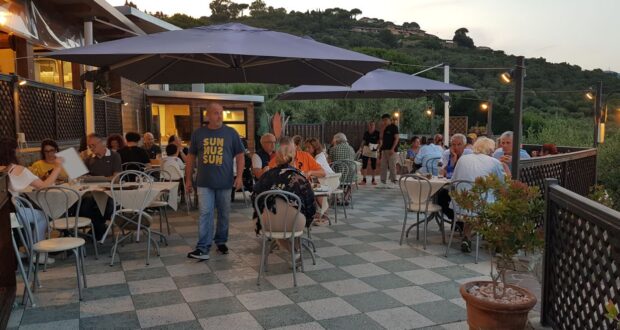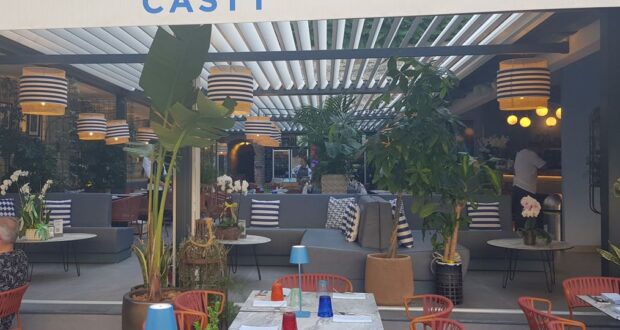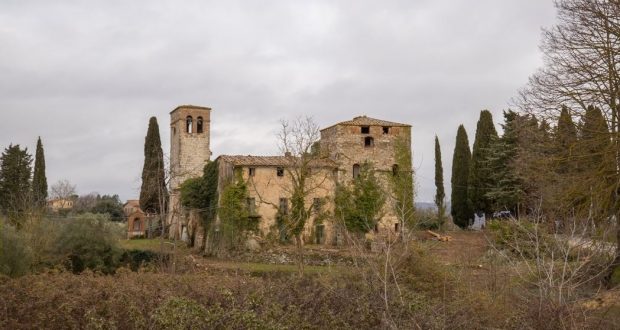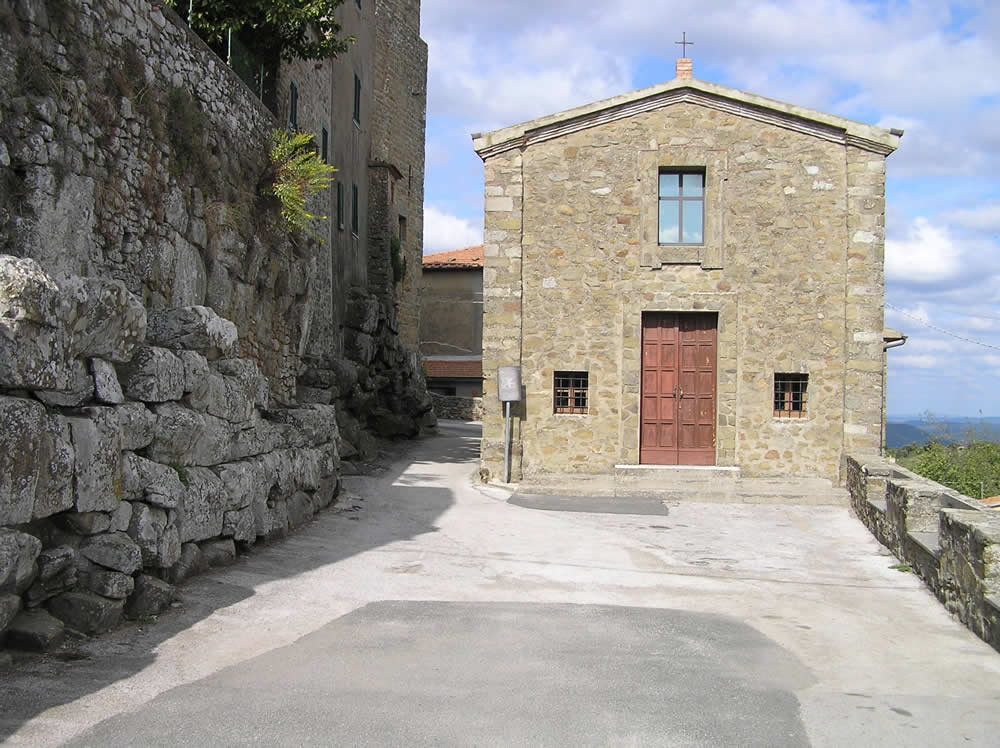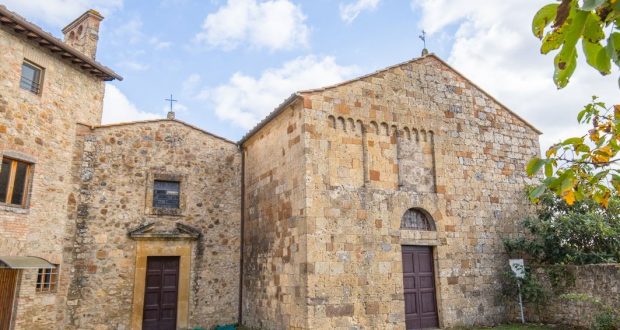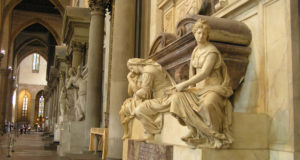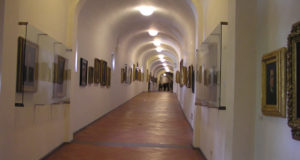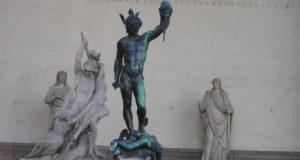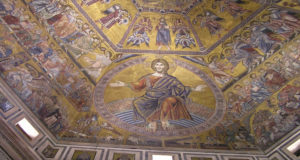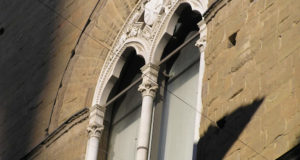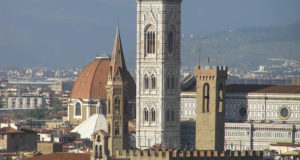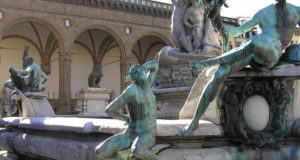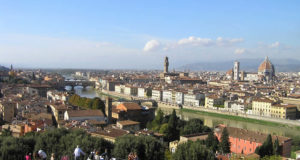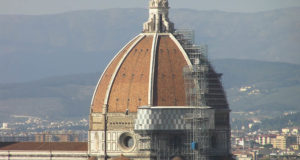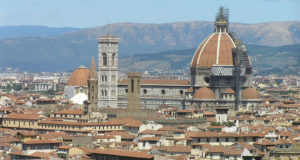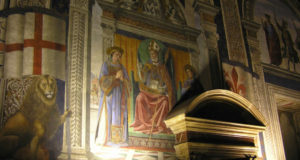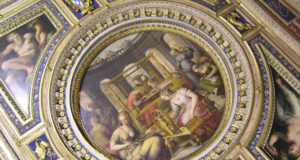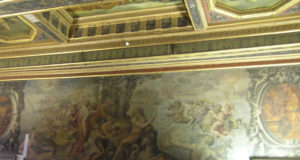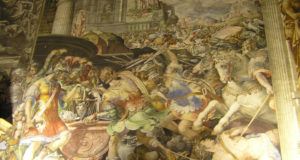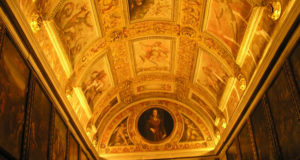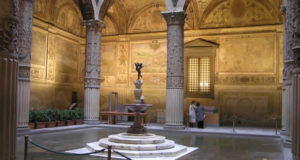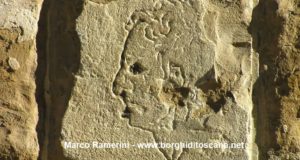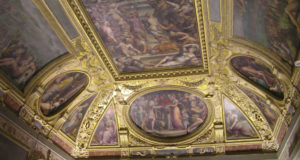Michelangelo Buonarroti’s Tomb is the work of Vasari (1570). The tomb is located at the beginning of the right nave of the church of Santa Croce, as soon as you cross the main door of the Basilica. Above the tomb there are three sculptures that represent the personifications of Painting, Sculpture and Architecture. These figures appear saddened by the disappearance ...
Read More »Vasari Corridor: a private passage on Florence
The Vasari Corridor it’s a covered way which connects Palazzo Vecchio (Old Palace) to Palazzo Pitti (Pitti Palace), passing through the Galleria degli Uffizi (Gallery of the Uffizi) and crossing the River Arno above the Ponte Vecchio (Old Bridge). The Corridoio Vasariano, more than one kilometer long and 3.50 mts large, was constructed, in only five months, by Giorgio Vasari ...
Read More »Statue of Perseus by Benvenuto Cellini: one of the most famous statues of Piazza della Signoria in Florence
Among the statues present today in the Loggia della Signoria or dei Lanzi, the Perseus by Benvenuto Cellini is probably the most important and extraordinary work from an artistic and technical point of view. This statue is considered a masterpiece of Italian Mannerist sculpture and one of the most famous statues in Piazza della Signoria in Florence. The famous bronze ...
Read More »Loggia della Signoria (Loggia dei Lanzi): an open-air museum
The Loggia della Signoria, also called Loggia dei Lanzi because of the guard of German mercenaries (lansquenets) who stood here in the sixteenth century, was built in the fourteenth century thanks to the work of Simone di Francesco Talenti, Lorenzo di Filippo and Benci di Cione. This structure was originally used to host indoor public popular assemblies and official ceremonies ...
Read More »The Baptistery of Florence: Saint John
The oldest monument in the Piazza del Duomo, is situated right in front of the facade of Florence Cathedral and is the Baptistery of Saint John. A first building was built already in the fifth or sixth century, this served as a baptistery and should already be octagonal as the present one. In the mid-eleventh century, the baptistery was reconstructed ...
Read More »Orsanmichele: church of arts and crafts of Florence
Originally, in the area where it is today Orsanmichele was the oratory of San Michele in Orto, which was demolished in 1239. In its place, around 1290, Arnolfo di Cambio built a loggia for the sale of grain, then according to tradition the image of the Madonna painted on a pillar began to make miracles, and the place became a ...
Read More »Gallery of the Academy: the Michelangelo’s David
The Galleria dell’Accademia (Gallery of the Academy of Florence), one of the most visited museums in Florence, is located on the premises of the fourteenth century Ospedale di San Matteo and the women’s monastery of S. Niccolò di Cafaggio. The gallery was founded in 1784 by Grand Duke Peter Leopold of Lorraine as a teaching collection for students of the ...
Read More »Giotto’s bell tower: masterpiece of Gothic architecture
Giotto’s bell tower is one of the most beautiful Italian bell towers. This structure is the bell tower of the Florence Cathedral of Santa Maria del Fiore. The bell tower is detached to the right of the Duomo. This position represents the intention of the designer to highlight the importance of the bell tower compared to other surrounding buildings. The ...
Read More »Piazza della Signoria: the center of political power
Piazza della Signoria is an open-air museum which, at every step, offers glimpses and panoramas of particular beauty. In this square there are testimonies of a thriving past and architectural treasures of enormous value. Which, then, are found a bit all over Florence. Famous in the world since ancient times, and probably the most important cultural center in Italy. Cradle ...
Read More »How to get by plane to Florence
Florence has not, unfortunately, a major international airport – as would be desirable given the tourist importance of Florence in the world – but only a small city airport. To reach the airport in Florence from intercontinental destinations you need to stop and change your flight, in European airports such as Paris, Rome, Munich or Frankfurt. Let’s see how to ...
Read More »How to get to Florence by train
The train is perhaps the most convenient method for a short holiday in Florence, the train arrives in the historic center of the city without having to worry about finding a parking, then you can safely move around Florence on foot or using the bus service of the town. The city has three main railway stations: Firenze-Santa Maria Novella, Firenze-Campo ...
Read More »Florence: the jewel of the Italian Renaissance
Florence, the jewel of the Italian Renaissance, is one of the most important art cities in the world. Considered the cradle of the Renaissance world, it is recognized worldwide among the top cities for art and architecture, with its numerous historic buildings, monuments, and rich museums. Including, to name just a few, the Uffizi Gallery, the Accademia Gallery, the Bargello ...
Read More »Brunelleschi’s Dome: the Dome of Florence
The largest masonry dome ever built by man Brunelleschi’s famous dome forms the cover of the Florence Cathedral and is the largest brick dome built by man. In fact, the major diagonal of the internal dome measures 45.5 meters, while the external one is 54 meters. The impost, which rises 35.50 meters above the tambour, is about 54 meters from ...
Read More »Florence Cathedral: Santa Maria del Fiore
The cathedral of Florence with its spectacular dome is together with the Ponte Vecchio, Palazzo Vecchio and the Uffizi the best known attraction in the city of Florence. Florence Cathedral has dominated the city skyline for hundreds of years. The dome above it is a unique work and an absolute masterpiece of architecture of all time. The construction of the ...
Read More »San Gimignano: medieval New York
San Gimignano was built in the 8th century as a walled feudal castle. In the following centuries the village became a free municipality. Then in 1353 the town became part of the possessions of the Republic of Florence. In the Middle Ages San Gimignano was an important stop for pilgrims who went to Rome along the Via Francigena. In the ...
Read More »Hall of the Lilies in Palazzo Vecchio, Florence
The Hall of the Lilies (Sala dei Gigli) takes its name from the floreal decorations on its ceiling and walls, it’s the only one Hall of Palazzo Vecchio that still today conserve the 15th century aspect. The Hall was obtained in 1472 from the division in two rooms of the Sala Grande carried out from Benedetto and Giuliano da Maiano, ...
Read More »Chapel of the Priors in Palazzo Vecchio, Florence
The Cappella dei Priori (Chapel of the Priors) also called Cappella della Signoria was built between 1511 and 1514 by Baccio d’Agnolo and its decoration was entrusted to Ridolfo del Ghirlandaio (Ridolfo Bigordi said il Ghirlandaio), son of the famous Domenico Ghirlandaio. The chapel is dedicated to St. Bernard and consists of two rooms with vaulted ceilings: the altar area ...
Read More »Apartments of Eleonora in Palazzo Vecchio, Florence
After the visit of the Apartment of the Elements cross the gallery from which it dominates the Salone dei Cinquecento and enter the Apartments of Eleanora. The Apartments of Eleonora is so named because when Cosimo I established his residence in Palazzo Vecchio this wing of the building was reserved to the rooms of his wife Eleonora of Toledo, daughter of the ...
Read More »Apartments of the Elements, Palazzo Vecchio, Florence
The visit of the second floor of the Palazzo Vecchio begins with the so-called Apartments of the Elements. These rooms were the private rooms of Cosimo I. In this section of the building are: the Hall of the Elements, the Hall of Opi, the Hall of Ceres with the Scrittoio di Calliope, the Hall of Jupiter, the Terrace of Juno, ...
Read More »Audience Hall in Palazzo Vecchio, Florence
We now reach the Sala dell’Udienza which was the Chamber of Justice, used for the meetings and hearings of the Signoria. Originally also on this floor there was a large hall, the Great Hall. Its dimensions were similar to those of the underlying Salone dei Duecento. But between 1470 and 1472 the room was divided, by the work of Benedetto ...
Read More »Study of Francesco I de’ Medici in Palazzo Vecchio
At the end of the wall of the Salone dei Cinquecento (the one where the entrance is), there is a small masterpiece of Florentine mannerism, the study of Francesco I (in Italian “Studiolo di Francesco I” also called Tesoretto or Scrittoio del Duca). It is a small side room without windows that was part of the private apartments of Francesco ...
Read More »The Courtyard of Palazzo Vecchio, Florence
The first courtyard of Palazzo Vecchio was built in the first half of the fourteenth century and then modified by Michelozzo in the fifteenth century. This architect replaced the pillars with cylindrical and octagonal columns and then built the loggia. In the second half of the 16th century, the entire building underwent major modification works carried out by Vasari at ...
Read More »Palazzo Vecchio: one of the symbols of Florence
One of the symbols of Florence, Palazzo Vecchio or Palazzo della Signoria was designed by Arnolfo di Cambio around 1299 as the residence of the Priors of the Arts, the palace was completed in 1314. The 94-meter-high tower of Palazzo Vecchio, called the tower of Arnolfo was built in 1310, together with the palace. It was probably supported by an ...
Read More »The Importuno by Michelangelo, Palazzo Vecchio
Florence is a historic city full of legends. Among these there is a singular one concerning Michelangelo Buonnarroti. The great artist author of the David and the Pietà could have made one of his works in a stone of Palazzo Vecchio. But what is most surprising in the legend is the way in which the artist would have created the ...
Read More »Quarters of Pope Leo X in Palazzo Vecchio
Hall of Leo X and the Hall of Clement VII The Quarters of Pope Leo X are on the first floor of the Palazzo Vecchio, these rooms were modernized by Giorgio Vasari in 1555-62. The decorations of the same Vasari and Gino Lorenzi, are dedicated to the most illustrious personages of the Medici family and their businesses. These rooms have been used in ...
Read More » Borghi di Toscana Guida ai borghi e ai paesaggi della Toscana
Borghi di Toscana Guida ai borghi e ai paesaggi della Toscana
